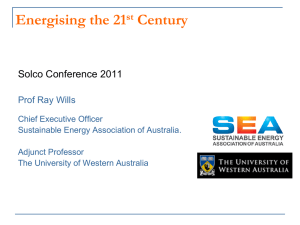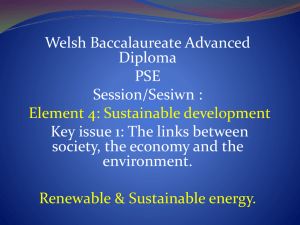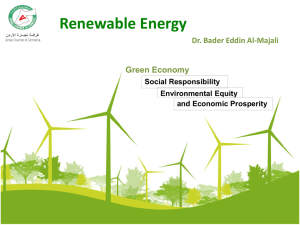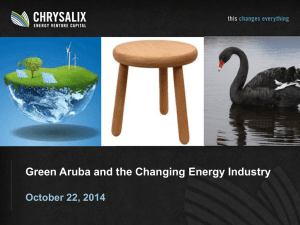Renewable Energy India Expo
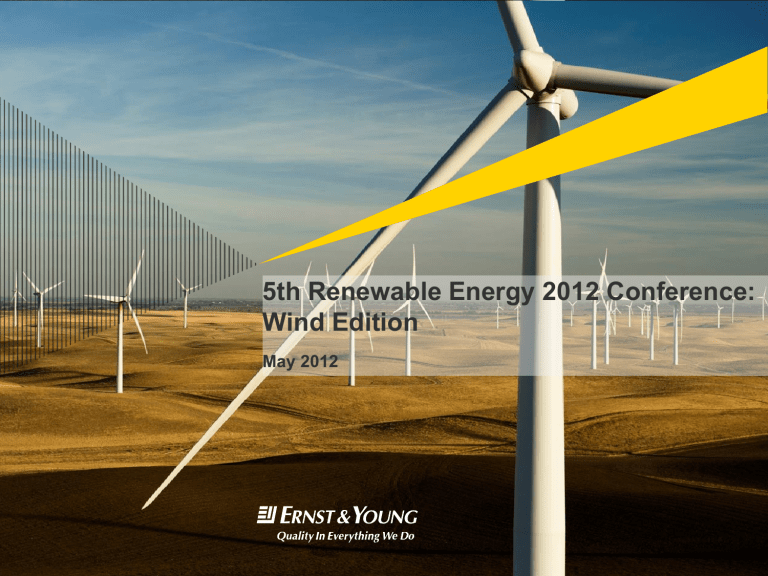
5th Renewable Energy 2012 Conference:
Wind Edition
May 2012
Power scenario in India
Growing importance of renewable energy
Break up of installed power generation capacity
12%
(as on 31 March 2012) ►
►
►
►
►
Renewable energy accounts for approximately 12% of a total 200
GW of power generation capacity installed in India.
Demand for power in India has been increasing due to the rising population, growing economy, and changing lifestyles.
Despite substantial capacity additions, the power sector is still in shortage of energy.
Peak demand shortage averages around 12%.
Renewable energy installed capacity has grown at a healthy CAGR of
19% over FY07-FY12.
20%
56%
Coal
Gas
Diesel
Nuclear
Hydro
Renewable
2%
1%
9% Source: CEA
Growth of renewable energy installed capacity in India (GW)
10,2
+2.1
12,3
+2.1
14,4
CAGR
19%
16,8
+3.2
+2.4
20,0
+4.5
24,5
FY07
Source: MNRE, CEA
FY08 FY09 FY10 FY11 FY12
Page 2
Renewable energy: growth story
Wind —the mainstay of renewable energy in India
►
►
Wind energy, with over 16 GW installed capacity, accounts for nearly 66% of the renewable energy installed in India.
Installed wind energy capacity in India has grown at a CAGR of 19% (FY’07-FY’11).
► The states of Tamil Nadu, Maharashtra and
Gujarat are the leaders in installed wind energy capacity.
► As per various estimates, the total potential for wind energy is around 46 - 70 GW.
► MNRE envisages wind to constitute ~70% of overall renewable capacity translating to 2-3 GW of new capacity per year till 2020.
Renewable energy installed capacity split in India
(As on 31 Jan 2012)
Solar
2%
Others
6%
Biomass
13%
Small hydro
13%
Wind
66%
Source: MNRE
Biomass includes bagasse cogeneration; Others includes Waste to power
Growth of Wind installed capacity in India (GW)
Resource Estimated potential (GW)
48.5
Wind
Small hydro
Biomass
15.4
23.0
Solar 20-30 MW/sq. km
As of 31 Jan 2012
Source: MNRE, Ernst & Young analysis
Installed capacity (GW)
16.2
3.3
3.0
2.1
7,1
+1.7
8,8
+1.4
CAGR
19%
10,2
11,8
+2.4
14,2
+2.0
16,2
+1.6
FY07
Source: MNRE
FY08 FY09 FY10 FY11 Jan' 12
Page 3
Ernst & Young Renewable Energy Attractiveness Indices
India is globally one of the most attractive destinations for wind energy
China
Germany
US
UK
India
Canada
Italy
France
Sweden
Poland
Wind All renewables
54
52
58
58
61
64
67
70
66
76
Source: Ernst & Young Renewable Energy Attractiveness Index, February 2012
Page 4
►
►
►
The Ernst & Young Renewable
Energy Country Attractiveness
Indices ranks renewable energy markets, their renewable energy infrastructure and suitability to various technologies.
The indices are forward looking and take a long-term view of the markets, ranking countries with high unexploited potential higher on the index.
India ranks fourth on EY’s most recent all renewables attractiveness index and fifth on the wind index owing to its vast unexploited potential and favorable government support.
Wind energy investment in India: experiencing growth but challenges remain
►
►
►
►
►
India is emerging as one of the fastest growing countries in terms of renewable energy investment.
India’s investment in renewable energy totaled
US$10.4 billion in 2011, growing 54% over
2010 — the second fastest among G-20 countries.
The wind energy sector attracted US$4.6 billion in 2011, or 44% of the total, adding 2.8 GW of capacity.
The wind energy sector attracted 67% of all
VC/PE capital and 98% of all new-build asset finance, raised YTD in India, across all forms of renewable energy.
Multilateral agencies such as the World Bank,
International Finance Corporation (IFC), and
Asian Development Bank (ADB), as well as bilateral agencies such as KfW (German
Development Bank) have also stepped up their assistance to the sector in the last few years.
New investment in clean energy, 2004 – 2011 (US$ b)
350
5,4%
300 3,8% 3,7%
3,3%
3,7%
2,3%
1,9%
2,7%
3,9%
250
200
150
100
50
0
2004 2005 2006 2007 2008 2009 2010 2011 1Q'12
Europe United States China India India as % of global
New investment in wind energy in India, 2004
–
1Q’12 (US$ m)
Asset finance Public markets VC/PE
6 000
5 000
4 000
3 000
2 000
1 000
0
2004 2005 2006 2007 2008 2009 2010 2011 1Q'12
Page 5
Changing paradigm of wind power:
GBI and REC are likely to transform the wind power space
2003
2003-09:
Investment Option
Depreciation driven
Balance sheet financed
Packaged solution
Sale to utility only
Annuity business
2012
2010- onwards:
Business Option
NPV/ IRR driven
Project finance
EPC/ EPCM etc
Multi-sale options
Risk-return framework
Together, the Generation Based Incentive scheme and Renewable Energy
Certificates are likely to transform the structure of the wind energy industry in India.
However, the repeal of the Accelerated Depreciation tax break will have an adverse impact on investment in the sector
Page 6
RPO regulations: a key step towards the promotion of renewable energy
►
►
► Renewable Purchase Obligations (RPOs) require the following obligated entities
►
►
► distribution licencees captive power consumers open access consumers to purchase/generate a certain percentage of their total electricity requirement from eligible renewable sources.
Progressive targets
State
Gujarat
Segment
Wind
Solar
Others
FY10-11
4.5%
0.25%
0.25%
FY11-12 FY12-13
5.0%
0.5%
0.5%
5.5%
1.0%
0.5%
Total
Biomass
Wind
5.0%
1.75%
6.75%
6.0%
2.00%
7.50%
7.0%
Rajasthan
Total 8.5% 9.5% 8.0%
Source: Respective State Electricity Regulatory Commission orders
To enhance compliance to the RE purchase obligations, a tradable market based instruments,
Renewable Energy Certificates (RECs), have been launched.
The REC mechanism will enable even states with lower RE potential to target higher RPOs and at the same time encourage developers to set-up RE facilities at most optimal locations.
Sold at preferential tariff
Renewable energy sources
Electricity
Sold at nonpreferential tariff
RECs
Trade/
Transact
Page 7
Critical success factors (1 of 2)
Technological factors
Financial factors
►
►
►
Power evacuation infrastructure has not kept pace with the development of wind power plants. Tamil Nadu provides an example of a state where many commissioned wind plants are unable to evacuate the energy generated because of lack of infrastructure.
Wind power generated fluctuates depending on wind speeds and availability.
The bulk generation of such intermittent/variable renewable energy creates significant disturbances to the grid.
The repowering of wind turbines, or the replacement of old and small turbines with larger and more powerful turbines, would lead to enhanced generation from the same site. However, this process has its own limitations such as ownership, cost, incentive and policy issues.
►
►
►
Continuous losses are being incurred by many state discoms, which is leading to significant delays in payments to wind generators.
► This also has a ripple effect on the lenders, who complain of nonregular repayment of loan installments.
Mechanism like REC financing and green bonds need to be strengthened and promoted as an alternative way to close the funding gap.
The implementation of the Direct Tax Code (DTC) and the Goods and
Services Tax (GST) will result in an increase in the cost structure for wind energy projects.
Page 8
Critical success factors (2 of 2)
Regulatory factors
Institutional factors
►
►
►
►
Strict implementation of RPO is a challenge and sector growth trajectory depends on the achievement of RPO targets set by state governments.
The removal of the accelerated depreciation (AD) benefit will weigh down on the investments in the wind energy sector.
The generation based incentive (GBI) scheme was launched in 2009 to provide a level playing field to players across various classes and to encourage energy generation as opposed to only capacity additions.
A favorable law and order system with single window clearance system is required .
►
►
►
►
Diversion of land and obtaining environmental and forest clearance is a long drawn procedure which leads to delay or suspension of projects.
India needs trained and skilled manpower to work in the sector to meet growth targets.
Structured training programs at institutions and development of industrial training institutes (ITIs) for imparting technical skills to locals will create employment and increase the availability of trained manpower.
The wind turbine and component supply chain needs to be strengthened to reliably and efficiently meet the growing demand.
Page 9


